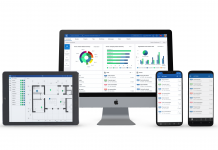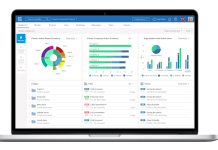Anthony Burd, Head of Market Development and Stephanie Kosandiak, Lead Programme Manager for Construction at BSI, outline the growing BIM landscape
The architecture, engineering and construction (AEC) industry previously relied on CAD and marked-up drawings to build. With the need to improve efficiency and reduce costs across the process, BIM software has filled the gap and shown that it can do both. The creation of a virtual 3D map (embedded with all the relevant data) of a building using digital technology, means that an accurate model can be constructed. This has major uses for everyone involved from the planning, design, construction and facility management aspects of the build, where all elements can be integrated and viewed by the architects, engineers and constructors.
Building in a simulated environment means that unforeseen issues can be corrected before any physical work can begin. As traditional methods have dominated the AEC industry for such a long time, this shift in process requires a shift in perception and working too. This includes a move towards a faster pace of working especially as BIM acts as a traceable database for the project. Therefore, all the associated costs of every design change can be tracked in real time. Stakeholders do not need to wait as long as they once had to, to see the implemented changes and can see what the final project will look like with demos and walkthroughs.
BIM is effectively changing the face of construction and is recognized not just by industry but the government as a key tool. As older methods eventually become obsolete, the AEC industry will have to adapt. In anticipation of the importance of BIM, BSI has developed a full BIM suite of standards to support the use of BIM.
The key BIM standards
BS 1192:2007 Collaborative production of architectural, engineering and construction information. Code of practice. The standard establishes the methodology for managing the production, distribution and quality of construction information, including that generated by CAD systems, using a disciplined process for collaboration and a specified naming policy.
PAS 1192-2:2013 Specification for information management for the capital/delivery phase of construction projects using building information modelling. The requirements within PAS 1192-2 build on the existing code of practice for the collaborative production of architectural, engineering and construction information, defined within BS 1192:2007.
It focuses specifically on project delivery, where the majority of graphical data, non-graphical data and documents, known collectively as the Project Information Model (PIM), are accumulated from design and construction activities.
PAS 1192-3 is the partner to PAS 1192-2, and focuses on the operational phase of assets irrespective of whether these were commissioned through direct capital works, acquired through transfer of ownership or already existed in an asset portfolio. Like PAS 1192-2, PAS 1192-3 applies to both building and infrastructure assets.
BS 1192-4:2014 Collaborative production of information Part 4: Fulfilling employers information exchange requirements using COBie – Code of practice COBie (Construction Operations Building Information Exchange), is required on all Government construction projects where information must flow into portfolio, asset planning and facility maintenance tools.
BS 1192-4 provides users with recommendations on how to use COBie to structure information required for the operation of an asset or facility during the construction process, supporting the processes outlined in PAS 1192-2 and PAS 1192-3.
BS 7000-4:2013 Design Management Systems: Guide to managing design in construction. This BIS funded revision has been radically updated to take into account the development of BIM within the construction industry. It replaces BS 7000-4:1996.
BS 8541 Series of Library Objects for architecture, engineering and construction – provides construction product manufacturers and suppliers with guidance on how to provide product information for inclusion in Building Information Models. It comprises
BS 8541-1:2012 Identification and classification,
BS 8451-3:2012 Shape and measurement and
BS 8541-4:2012 Attributes for specification and assessment.
Upcoming BIM standards
There are several standards that work in synergy with the BS 1192 suite of standards. The key ones expected in 2015 are: BS 8541-5 and BS 8541-6.
As BIM Level 2 becomes more widely adopted in the UK, BSI is adding two new British Standards to the BS 8541 Library Object series in early 2015. They provide best practice recommendations on how to develop library objects for assemblies and product and facility declarations.
– BS 8541-5 Library objects for architecture, engineering and construction: Assemblies (on the sharing of sub-models representing combinations of components and spaces covering naming, classification and nesting) and;
– BS 8541-6 Library Objects for architecture, engineering and construction: Product and facility declarations – Code of practice (on the sharing of data expected from product declarations, labelling and environmental tables) will be published in February or March 2015.
Lead Technical author, Nick Nisbet, explains, “Repeatable rooms and prefabricated modules, on the one hand, and the Construction Products Regulation and energy performance reporting on the other, are issues of growing importance in the construction sector. These codes of practice build on the earlier parts of the series to help the industry achieve higher quality and accuracy when exchanging product (and facility) information.”
BS 8536:2010 Facility Management briefing is being revised as Facility Management briefing for design and construction – Code of practice, to take into account current industry best practices in briefing and the emergence of the soft landings process and BIM. The revised standard will give recommendations for design and construction to ensure that design= takes account of the expected performance of the asset/facility in use over its planned operational life.
BS 8536:2015 will introduce the integration of the principles of the soft landings process, combined with effective information management and the requirements for post-occupancy evaluation (POE) to strengthen the link between asset/facility owners, operators, and their facility managers and the design and construction team to assure performance of the design and the operational asset/facility in all aspects.
The standard cross-references information requirements associated with the mandated documents for BIM Level 2 PAS 1192-2, PAS 1192-3 and BS 1192-4 and is expected to publish in July 2015. BS 8536:2015 is intended for use by individuals and organizations preparing or contributing to design, construction and operations, in both the public and private sectors, including owners refurbishing an existing asset/facility, organizations procuring a new asset/facility and the designers, constructors, subcontractors, operators, operations teams, facility managers and other specialists engaged in such activities.
PAS 1192-5. The UK BIM Task Group’s “Security Working Group” announced late last year at “ICE BIM 2014: Business as Usual” Conference in London that “PAS 1192-5: Specification for security-minded building information management, digital built environments and smart asset management”, is currently in development.
The PAS will outline a risk assessment process to determine the sensitivity of information already held, or which will be acquired during the course of a project, and identify appropriate, proportionate security requirements for BIM collaboration which should be applied during all phases of the lifecycle of an asset, i.e. concept, design, construction, operation and disposal. It will then address the steps required to assist in creating and cultivating an appropriate security mind-set, and the secure culture necessary to enable business to unlock new and more efficient processes and collaborative ways of working.
The intended audience for this PAS includes organisations and individuals responsible for the procurement, design, construction, delivery, operation and maintenance of buildings and infrastructure assets. Although specifically targeted at the use of Level 2 BIM, the requirements will provide a foundation to support the evolution of future digital built environments and will contribute to smart asset management.
The standard is expected to publish in quarter two in 2015.













